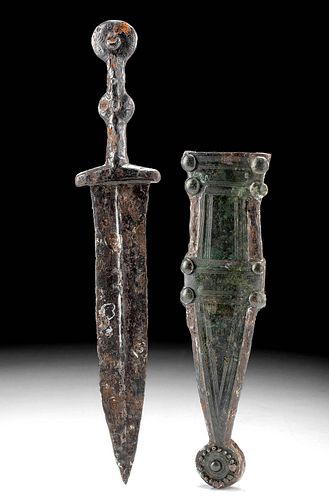Roman Steel Pugio Dagger w/ Ornate Bronze Scabbard
Lot 43a
About Seller
Artemis Fine Arts
686 S Taylor Ave, Ste 106
Louisville, CO 80027
United States
Selling antiquities, ancient and ethnographic art online since 1993, Artemis Gallery specializes in Classical Antiquities (Egyptian, Greek, Roman, Near Eastern), Asian, Pre-Columbian, African / Tribal / Oceanographic art. Our extensive inventory includes pottery, stone, metal, wood, glass and textil...Read more
Categories
Estimate:
$4,000 - $6,000
Absentee vs Live bid
Two ways to bid:
- Leave a max absentee bid and the platform will bid on your behalf up to your maximum bid during the live auction.
- Bid live during the auction and your bids will be submitted real-time to the auctioneer.
Bid Increments
| Price | Bid Increment |
|---|---|
| $0 | $25 |
| $300 | $50 |
| $1,000 | $100 |
| $2,000 | $250 |
| $5,000 | $500 |
| $10,000 | $1,000 |
| $20,000 | $2,500 |
| $50,000 | $5,000 |
| $100,000 | $10,000 |
| $200,000 | $20,000 |
About Auction
By Artemis Fine Arts
Oct 8, 2020
Set Reminder
2020-10-08 10:00:00
2020-10-08 10:00:00
America/New_York
Bidsquare
Bidsquare : Exceptional Antiquities, Asian, Ethnographic
https://www.bidsquare.com/auctions/artemis-gallery/exceptional-antiquities-asian-ethnographic-5796
Museum-worthy examples of Egyptian, Greek, Roman, Etruscan, Near Eastern, Far East / Asian, Pre-Columbian, African / Tribal,Oceanic, Native American, Spanish Colonial, Russian, Fossils, Ancient Jewelry, Fine Art, so much more! Artemis Fine Arts info@artemisgallery.com
Museum-worthy examples of Egyptian, Greek, Roman, Etruscan, Near Eastern, Far East / Asian, Pre-Columbian, African / Tribal,Oceanic, Native American, Spanish Colonial, Russian, Fossils, Ancient Jewelry, Fine Art, so much more! Artemis Fine Arts info@artemisgallery.com
- Lot Description
Roman, Imperial Period, ca. 1st to 2nd century CE. A handsome cast steel short dagger, known as a pugio with an ornate bronze and steel scabbard. The pugio has a short handle, a round pommel and midsection with two small nodules, and a wide flat guard. The broad blade tapers to a point, with a midrib that runs down the center to the tip. The steel scabbard mirrors the shape of the blade, but with a central bronze inlay and incised lines adorning the edges. Eight rivets secure the bronze inlay to the scabbard, and the tip is capped by a bulbous terminal with a central rivet and smaller encircling nobs and etched lines. The verso side of the scabbard is unadorned. Pugios were a sidearm for Roman soldiers to use in close combat for stabbing their opponent. Of course, the ornate sheath also let others know the elite status or wealth of the soldier when hanging at his side! Total size: 13.125" L x 2.25" W (33.3 cm x 5.7 cm); size of sheath: 8.75" L (22.2 cm)
Pugios were not only a soldier's weapon, but senators and even emporors carried these small daggers concealed in their clothing for protection or to carry out dasterdly deeds. Perhaps most infamously the Ides of March 44 BCE assasination of Juius Caesar was carried out with pugio blades. Pugio comes from the word for fist or boxer, indicating this dagger was ideal for stabbing rather than slicing.
Provenance: ex-Estate of Eldert Bontekoe, Pegasi Numismatics, Ann Arbor, Michigan, USA acquired before 2000
All items legal to buy/sell under U.S. Statute covering cultural patrimony Code 2600, CHAPTER 14, and are guaranteed to be as described or your money back.
A Certificate of Authenticity will accompany all winning bids.
We ship worldwide and handle all shipping in-house for your convenience.
#158880Surface wear, abrasions, chips and nicks to blade. Fissures with radiating lines on pommel. Surface wear and abrasions to scabbard. Rich patina and the blade still fits in the scabbard!Condition
- Shipping Info
-
All shipping is handled in-house for your convenience. Your invoice from Artemis Gallery will include shipping calculation instructions. If in doubt, please inquire BEFORE bidding for estimated shipping costs for individual items.
-
- Buyer's Premium



 EUR
EUR CAD
CAD AUD
AUD GBP
GBP MXN
MXN HKD
HKD CNY
CNY MYR
MYR SEK
SEK SGD
SGD CHF
CHF THB
THB














